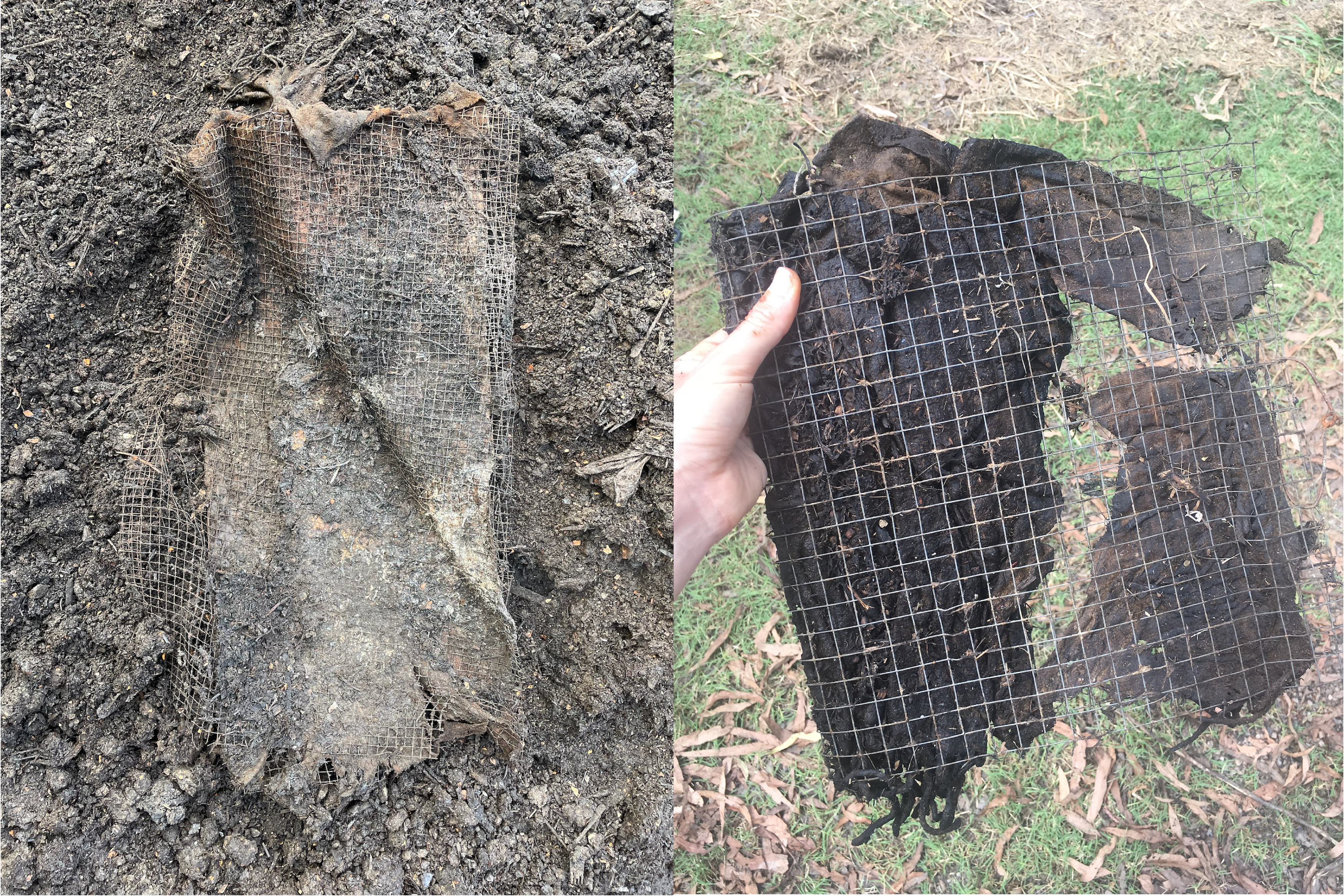
There’s lots of ways to repair and re-use old woollen blankets. And of course, if the right systems are in place, they can be mechanically recycled into new blankets. But if old blankets are beyond saving, and they’re 100% wool, then they can be composted within a natural closed-loop system!
Wool will naturally decompose in the ground as fungi and bacteria break it down, and even return valuable nutrients back into the soil. We were inspired to explore this idea further as healthy soil is not only a resource for healthy food, but a carbon drawdown mechanism itself.
So we embarked on an experiment to see what would happen if we composted a 100% natural woollen blanket. We took a wool blanket sample (50% recycled wool and 50% virgin wool) to the Yandina Community Gardens on the Sunshine Coast, which runs a local circular program called Food Waste Loop.

Food Waste Loop composts the food waste of eleven local businesses to create a high quality compost product which is sold locally as garden food
The Yandina Community Gardens were a great place to visit – beautiful water plants grow beside plots of vegetables, and the composting area smells of coffee grounds, which was unexpectedly pleasant. We were warned, however, that changes in the weather and types of food scraps can change the smell drastically!

Setting up the compost
Together with the Food Waste Loop team, we introduced half the all-wool blanket sample into a home compost system and the other half into the industrial compost system to break down over time.

Pat (left), Meg (middle) and Emily (right) play with the blanket before it gets cut up for the experiment
The samples were wrapped in chicken wire that could be extracted from the compost piles, to ensure we could document the break-down process.

Pat clamps the woollen blanket sample in between sheets of chicken wire
The commercial compost pile contains food waste from food businesses in Yandina mixed with straw and goat manure. It sits at around 70 degrees for a minimum of 12 weeks, allowing the microbes to do their work without the effect of bad bacteria. Every two weeks the compost was ‘turned’, or aerated.
 The commercial compost pile is hot!
The commercial compost pile is hot!
The home compost bin was filled with a mix of food waste (fruit and vegetable waste only) and carbon product (for example, wood chips or straw). Every week for the first five weeks, additional food scraps and carbon was added to replicate a home compost environment, and the compost was turned every two weeks.
 Emily prepares food waste for the home compost
Emily prepares food waste for the home compost
After three months
In the commercial compost, at twelve weeks, the material had become weak and able to rip easily, but was still holding together.
In the home compost, the material disintegrated with minimal effort. Some form was still visible at this point.
 Week 12 decomposition in commercial compost (left) and home compost (right)
Week 12 decomposition in commercial compost (left) and home compost (right)
After six months
The sample in the commercial compost pile was completely broken down at 24 weeks, or just over five months.
At six months the sample in the home compost was still working away – it’s very weak and on track to decomposing but still holding some form. Wool is very strong!
 Blanket sample in commercial compost (left) and home compost (right)
Blanket sample in commercial compost (left) and home compost (right)
Testing compost for soil health
We sent a portion of the commercial compost that included the wool blanket sample to a lab to test if this final product met certain elements of the Australian Compost Standard in regards to minerals, heavy metals and pesticide contamination.
The test determined that the product can in fact be used as a soil conditioner, or food, to grow healthy plants. The product has balanced levels of important minerals such as nitrogen, phosphorus and potassium, contains a whole suite of trace elements like zinc, copper and iron, and is an ideal source of organic matter.
Now this compost containing our decomposed blanket is being used to grow nutrient-dense food by the volunteers at the community gardens!
Want to compost your woollens?
Before considering composting your woollens, make sure your blanket or garment can’t be used by someone else first. After all, keeping materials in use for as long as possible is one of the key principles of the circular economy.
If you’re ready to compost your woollens, think about the worms first! Composting worms need conditions to be moist, warm and dark so a 100% natural blanket is the perfect thing to lay on top of the worm farm.
 Emily and Meg check on the worms in the industrial worm farm. As well as hessian, woollen blankets work in home worm farms to keep the worms warm!
Emily and Meg check on the worms in the industrial worm farm. As well as hessian, woollen blankets work in home worm farms to keep the worms warm!
If you don’t have a worm farm at home or nearby, the next step would be to incorporate your woollens into the compost heap. Be sure to cut down your garment or blanket into strips to allow it to break down faster. If you’re curious and want to track progress, enclose your wool in a chicken wire clamp as we did, so you can fish it out and check how it’s breaking down over time. While this trial was successful, we're not able to verify that other wool products will produce a compost product safe for growing food (due to dyes etc).
Can I compost my Seljak Brand blanket?
Not yet. Currently Seljak Brand blankets include a component of synthetic fibres like polyester and polyamide, which is used to bind the recycled fibres together and create a strong and durable yarn, and plastic cannot be composted.
We are aiming to operate in biological, as well as mechanical, closed-loop systems, which is why we’re scoping opportunities to use all-natural products in the future.
 Beautiful tropical water plants at Yandina Community Gardens
Beautiful tropical water plants at Yandina Community Gardens

